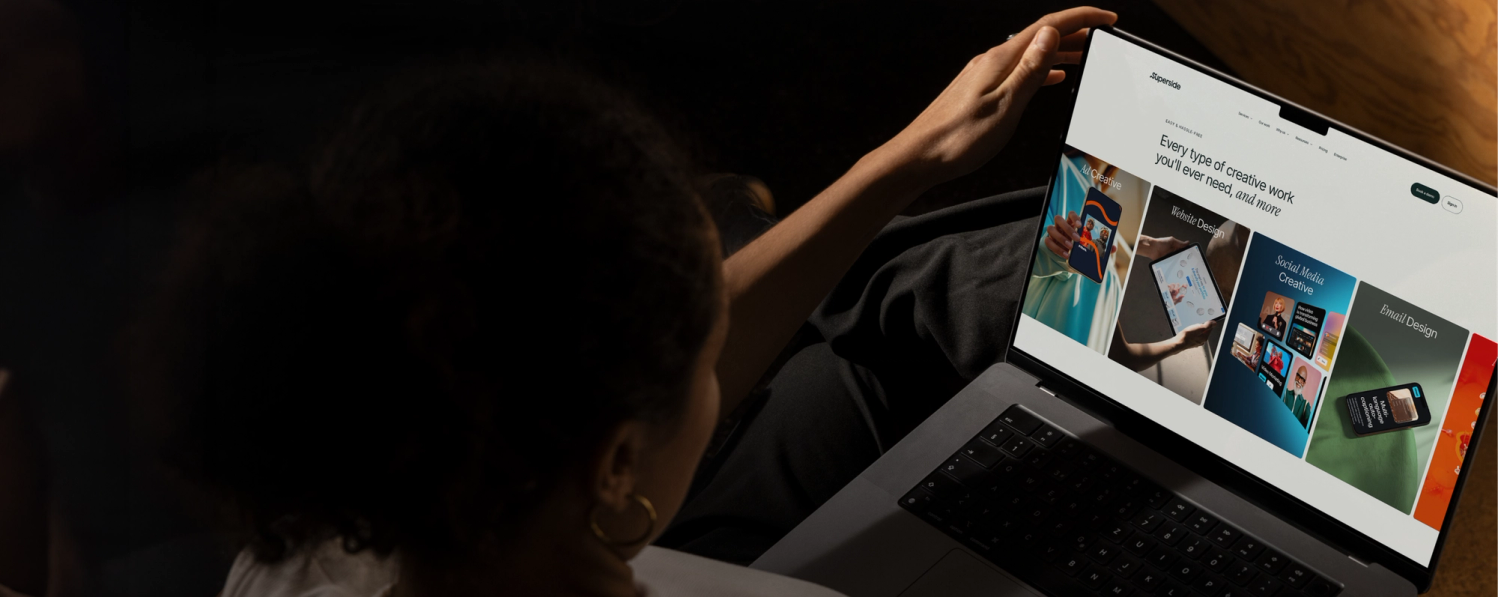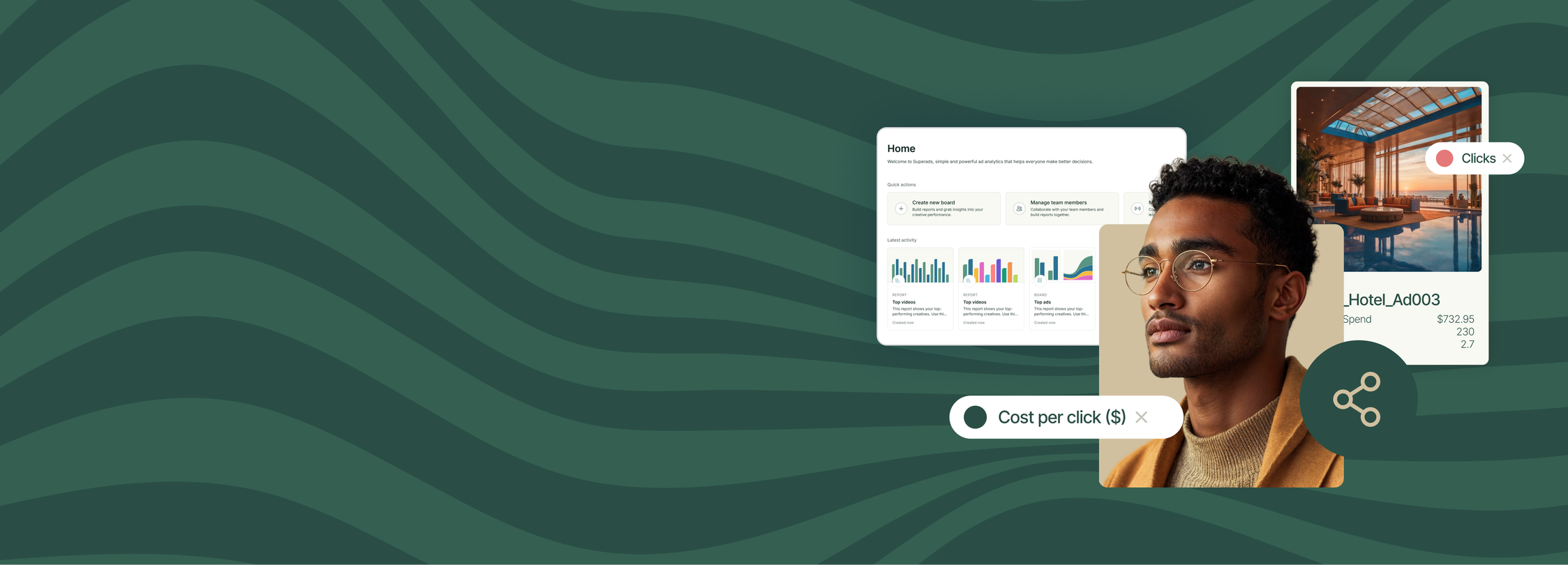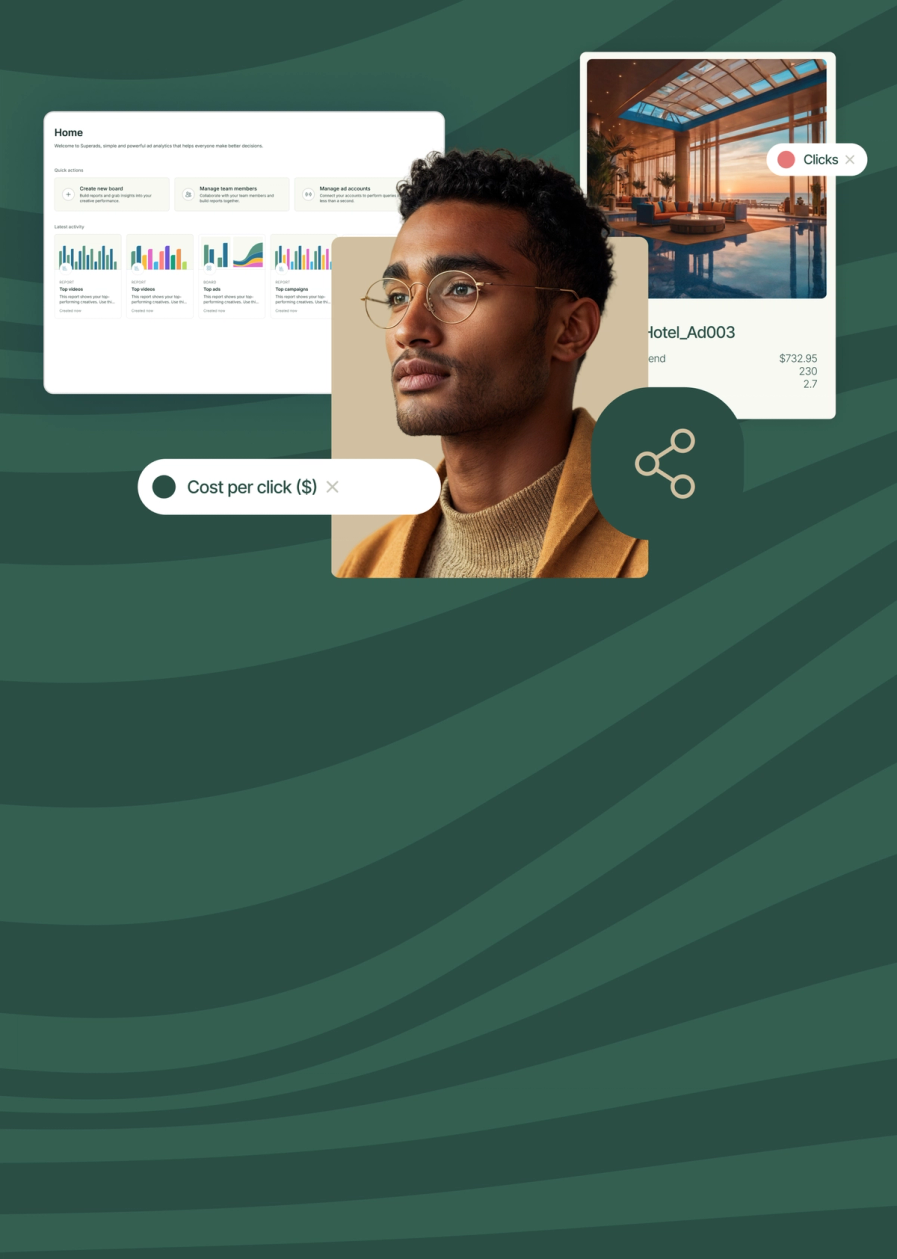
Good ad design stops scrolling users in their tracks, generates leads and helps brands make a lasting impression. To inspire your next campaign, we share 12 outstanding advertising design examples that showcase the art of impactful storytelling and effective branding.
Great ads can convert casual viewers into paying customers. Bad designs could send them straight to the competition. A thoughtful, eye-catching design grabs attention, builds trust and reinforces your brand identity, making every ad an essential component of a successful campaign.
In 2025, advertising trends are pushing creativity to new heights, which means standing out is becoming increasingly tough. And with so many advertising channels available to marketers, deciding where to channel your budget—and which ads to develop—can be hard.
Superside’s creatives are masters at creative productivity and high-converting advertising design. We asked them for notes on the 12 types of advertising design and tips and tricks to inspire your next campaign.
What is advertising design?
Advertising design merges marketing and graphic design to produce visual artwork specifically intended for advertisements. It involves much more than merely establishing your company’s visual brand identity. Its primary goal is to increase sales.
Ad design is about developing eye-catching creative that conveys a message and inspires action. This type of design uses on-brand typography, colors, images, motion graphics, videos and clear call to actions (CTAs) to engage your target audience and encourage them to, for example, visit your website or make a purchase.
Ad design is everywhere—from attention-grabbing trade show booths and engaging social media carousels to witty billboards that catch you off guard in traffic. When executed effectively, ads get noticed and remembered.
Today’s brands have many ways to reach customers with ads. Watch this video to discover your options.
7 tried and tested advertising design techniques
Create eye-catching advertising campaigns that deliver results with these top tips:
1. Tell a tale—stories stick, facts fade
People remember feelings, not numbers, hard facts or statistics. Emotional storytelling in ads drives action and connects with audiences. In fact, emotive stories can boost sales by 23%.
Take Google’s “Parisian Love” Super Bowl ad, which uses a simple search bar to convey a touching love story that tugs at the heartstrings.
2. Keep it simple
Consumers form impressions in just 50 milliseconds, so your ad designs need to be simple. Less really is more.
Avoid cluttering your advertisement with too many ideas. Instead, focus on a single, clear and concise message. Every word and visual should align with your brand identity and what you’re trying to say, ultimately helping to drive brand recognition.
Take advantage of current brand design trends such as augmented reality or minimalistic design, as these can help your brand stand out. You’ll also avoid appearing outdated.
3. Always include a clear CTA
A prominent CTA can boost ad conversion rates by 161%. Your audience needs clear instructions, like “Shop now” or “Discover more.” Make it obvious and persuasive.
An excellent example is Spotify’s “Listen on Spotify” button, which is used across its advertising campaigns. It’s direct and simple—everyone knows what they’re supposed to do.
4. Use brand elements to increase recognition
Brand consistency is a key factor in successful campaigns. Brand colors, for example, enhance brand recognition and can boost brand awareness by 80%.
To maintain consistency, embed your brand guidelines directly into your team’s design tools, such as Figma and Canva. By centralizing these guidelines within the software they use daily, you streamline workflows, reduce errors and guarantee that every campaign aligns with your brand’s identity and messaging.
5. Prioritize the mobile experience
Size matters—on screens, that is, because most engagement happens on mobile phones.
Focus on simplicity and avoid complicated details. If it doesn’t work on mobile, it won’t work at all. Capture attention quickly with concise messaging, bold visuals, on-trend creative and fast load times. This ensures higher engagement and prevents users from skipping over the content.
Instagram Stories ads are, for example, great to use if your audience spends time on this platform. These ads occupy the entire vertical screen, aligning perfectly with how users naturally hold their smartphones. The format eliminates distractions and ensures the ad is the sole focus of the viewer’s attention.
6. Use striking visuals—images stick better than words
Humans process visuals 60,000 times faster than text, and 90% of information sent to the brain is visual. In our current “more is more” culture, good communication relies on striking imagery, sharp graphics and eye-catching videos.
Take Nike’s striking black-and-white portraits of athletes featuring minimal text. The bold images convey a clear message: “Just do it.” Nothing could be more on-brand.
7. Use holidays, seasonal trends and local specifics
Unused seasonal moments are missed opportunities. Holidays, tactical events and even crises offer relevant marketing possibilities.
Savvy marketers capitalize on these occasions to connect with audiences meaningfully, tapping into the season’s emotions (e.g., creating memorable moments under the Christmas tree) or creating a sense of urgency (e.g., shopping before the clock strikes 12am on Black Friday).
A case in point: The Nando’s Bright Sides campaign took advantage of South Africa’s power cuts by offering free side dishes based on the severity of so-called “load shedding.” This campaign helped them win new customers and turn loyal ones into brand ambassadors.
12 types of advertising design with examples
Ready to put your knowledge to the test? These 12 advertising design types and examples will help inspire your next campaign.
1. Video and commercial ads
Great video ads capture attention, communicate complex messages clearly and create emotional connections that boost brand recall. In fact, 95% of marketers consider them vital to their digital marketing strategies.
Creating high-quality videos can be resource-intensive, requiring substantial time and financial investment. This is why many companies turn to creative outsourcing to enhance their brand without overspending.
On YouTube, video ads are easy to skip, which could limit their reach and effectiveness. To maximize impact, focus on visual design elements that immediately grab attention and convey your message within the first few seconds. Bold visuals, dynamic motion, clear branding and highly creative ads can hook viewers in a short time frame.
Example: Niche software company Bolt collaborated with Superside to create a vibrant, bold and energetic ad that conveys one key message: Checkout is easy.
We used motion graphics with a dash of surrealism, combining 2D and 3D animation for high-quality design. The result was a 600% increase in creative output.
2. Influencer and content marketing design
Traditional ads can be pushy, while influencer marketing feels more genuine, like a trusted friend recommending a wonderful new restaurant.
Influencers can give your brand an authentic voice and help develop loyal communities. Approximately 82% of consumers report following influencer recommendations. With the influencer industry expected to grow to $500 billion by 2027, this represents a tremendous opportunity.
Design plays a crucial role in influencer marketing, directly impacting how your brand is perceived within a carefully curated feed. By thoughtfully combining the right filters, fonts, colours and images, you can ensure your brand integrates seamlessly into the influencer’s visual narrative, enhancing authenticity and engagement. At the same time, your brand should also be instantly recognizable.
(Source: Daniel Wellington)
Example: Luxury watch brand Daniel Wellington pioneered the influencer marketing approach to marketing. The brand sent minimalist watches to micro- and mega-influencers, generating valuable content.
Influencers, including Kendall Jenner, featured the watches as personal style choices rather than just product photos. Within three years, Daniel Wellington achieved $228 million in sales.
As social media reaches an impressive 63.9% of the global population, placing ads on platforms like Facebook, Instagram and LinkedIn has become a key way to reach customers. Social media campaigns can be hard work, though, as each creative has to be tailored to the platform’s unique specifications and user behaviors.
The social media space is also crowded, and many users no longer pay attention to ads. Algorithm changes can also affect ad visibility and performance.
To stand out, it’s critical to create eye-catching ad creative and stay updated with the latest social media design trends.
(Source: Spotify)
Example: Spotify stands out by creating a personalized experience every December with its Wrapped feature. Rather than simply listing what users listened to during the year, it turns that data into an engaging, personalized visual story.
Wrapped uses bright colors and fun infographics to encourage users to share their personalized music stories on social media. In 2023, 227 million users accessed their custom Wrapped compilations, and in 2024, the campaign reached 184 markets, demonstrating its popularity.
4. Display advertisements
Display ads (e.g., banner ads, native ads, pop-ups) are designed to attract attention and drive traffic to owned brand channels (e.g., a brand’s homepage or online shop).
While they can deliver good results, many consumers suffer from “banner blindness,” completely ignoring them. Standard display ads have an average click-through rate (CTR) of just 0.1% (low engagement, in other words).
In 2025 and beyond, the choice to use display ads should form part of a larger creative branding strategy. Although effective for brand visibility and retargeting, display ads work best when used in conjunction with campaigns in other channels (e.g., social media ads, Google ads or email promos).
(Source: Katiem Willis)
Example: Email marketing service Mailchimp ran a display ad campaign featuring playful rhymes like “Jailblimp?” and “KaleLimp?” to highlight common mispronunciations of their brand name. This playful approach showcased Mailchimp's quirky personality and made the brand more relatable.
5. Direct mail
Direct mail is making a strong comeback as it stands out in an increasingly crowded digital world, offering a tangible, personal way to connect with target audiences. Direct mail includes postcards, catalogs and brochures sent directly to consumers’ mailboxes.
With an impressive open rate of 80-90%, direct mail significantly outperforms email’s 20-30%. However, design errors can be costly, especially for large campaigns, and paper waste is a concern.
On the positive side, direct mail feels personal. Since it arrives in a physical mailbox, people are likelier to notice and read it. A well-designed ad can remain on a target customer’s fridge for months.
(Source: Marketreach)
Example: Nestlé's KitKat Chunky launched a marketing campaign encouraging consumers to visit stores. They created a pamphlet that looked like the delivery cards left by postmen, which typically say a package is “too big for your letterbox.”
The KitKat letter humorously claimed the candy bar was “too chunky for your letterbox” and encouraged recipients to collect a free KitKat Chunky from their local newsagent. An impressive 87% of recipients did.
6. Outdoor ads
Out-of-home (OOH) advertising targets consumers outside their homes with ads on eye-catching billboards or posters in train stations or bus stops. Unlike digital ads, they can’t ignore them as easily on their daily commute.
In 2024, outdoor ads generated $2.78 billion in revenue in the United States. Although they’re not typically displayed where sales happen, outdoor ads are effective for spreading a message across a city, launching new products, enhancing digital campaigns or building brand awareness.
For outdoor ads to succeed, the messaging must be simple, bold and quickly understandable. You only have a few seconds to make an impact, so strong messaging and eye-catching design are essential.
(Source: The Drum)
Example: BrewDog, the indie craft brewery renowned for its bold approach, brilliantly mastered outdoor advertising with its playful “cold beer” billboards.
Displayed across 10 cities in the United Kingdom, the campaign showcased BrewDog’s newest brew with soft hues and a vintage vibe. By leveraging the straightforward phrase “cold beer,” it struck a chord with the local audience, ensuring the ads were eye-catching amidst the hustle of urban areas like London.
7. Email marketing
Email marketing is a highly targeted strategy that delivers personalized messages directly to customers’ inboxes, helping to promote products and services, share updates and build meaningful relationships.
Email marketing delivers a high return on investment (ROI), averaging $36 for every dollar spent, which equates to a 3,600% ROI. Custom-designed email templates remove the heavy lifting that successful email marketing requires.
Example: Superside’s newsletter, The Creative Brief, is a great example of an email that delivers results. This weekly email offers real-world examples, insights and stories for over 50,000 marketers. We incorporate humor, punchy copy, vibrant colors, high-quality graphics and compelling CTAs to drive readers to our website.
Our list of the best email design examples includes other great examples to inspire your next email campaigns.
8. Event advertising
Event advertising promotes specific occasions, from conferences and webinars to concerts and symposiums. Usually, event marketing invites participation and engagement, and creates excitement around upcoming events.
A significant 83% of marketers view events as essential for business growth, noting that virtual events can’t quite replace face-to-face interactions and immersive experiences.
Effective event advertising starts with thoughtful planning and works best when aligned with a clear marketing strategy.
(Source: Newsbreak)
Example: On Valentine’s Day, Vita Coco set up a DIY vending machine in Washington Square Park, New York, offering free products to the community. The vending machine and its vibrant graphic design attracted large crowds, with many people lining up to participate in the activation.
9. Newspaper and magazine ads
Globally, print circulation revenue fell from $58.7 billion in 2019 to $50.4 billion in 2024, reflecting an annual compound decline rate of about 3%. However, despite a significant decline in print advertising revenue, newspaper and magazine ads still have a place.
Print ads have a premium feel, and print publications are often placed on coffee tables and in hair salons, where customers are less distracted than they are online. Print ads are also ideal for longer-form storytelling, featuring captivating visuals that appeal to niche audiences.
There’s a caveat, though. Print advertising lacks the creative performance data and clickable links digital ads offer. Therefore, consider them part of your overall enterprise marketing strategy, complementing your digital efforts for a more substantial brand presence and broader audience reach.
(Source: Ads of the World)
Example: Land Rover’s 2012 “Passport” print campaign featured a passport page filled with stamps arranged to form the shape of a Land Rover. With no car images or excessive taglines, it showcased how impactful graphic design can be without explicit explanation.
10. Broadcast ad design
Broadcast ad design focuses on creating advertisements for TV, radio and streaming services, using motion, sound and storytelling to engage audiences in 15 to 60 seconds.
Despite the rise of digital platforms, broadcast advertising remains highly effective for reaching large audiences. For instance, 88% of Americans tune into the radio weekly, outpacing platforms like Facebook.
These ads combine broad reach with sensory appeal and can impact millions at once. However, high production costs, limited targeting options and distracted audiences count against them.
Carefully consider these factors before integrating broadcast advertising into your marketing strategy.
(Source: Creative Review)
Example: Old Spice’s “The Man Your Man Could Smell Like” is a prime example of exceptional television advertising. With its fast-paced monologue, surreal one-shot transitions and bold graphic design, the ad is both humorous and polished.
Every element, including the set design and sound, is designed to feel fresh and memorable.
11. Experiential advertising design
Experiential advertising involves immersive, interactive experiences that captivate target customers, leaving a lasting impression and fostering a deeper emotional connection with the brand.
As much as 85% of consumers are more likely to buy after attending these events, including pop-ups, trade shows, branded installations, VR activations or public stunts.
Graphic design is key in experiential advertising, particularly in areas like environmental design. Elements such as layout, materials, lighting, flow, interactivity and aesthetics help create engaging, memorable experiences.
These campaigns can be expensive and logistically challenging to create. However, get them right, and you’ll reap the rewards.
Example: Volkswagen converted subway stairs into big piano keys to encourage commuters to use them, promoting exercise in a fun way. This initiative was part of their “Fun Theory” campaign and successfully grabbed the world’s attention.
12. Point-of-purchase advertising design
Point-of-purchase (POP) advertising targets consumers right where they shop, using displays, signage and promotions to influence their buying decisions in-store.
This type of targeted advertising includes, for example, signs or tags attached to shelves near products to highlight their features. POP advertising aims to grab customers’ attention when they’re primed to buy. It prompts impulse purchases and highlights special offers and new items.
Effective POP advertising uses graphic design to catch the eye without distracting shoppers. Clear, bold messaging helps people quickly grasp the offer.
(Source: RXBAR)
Example: RXBAR nailed POP advertising by transforming simplicity into eye-catching appeal. Their straightforward displays featuring phrases like “3 Egg Whites. 6 Almonds. No B.S.” reflect their minimalist packaging, making them stand out in the snack aisle.
The brand’s clean design and strategic ad placement fuelled its growth, resulting in Kellogg’s acquiring RXBAR for $600 million.
Superside: Your agile ad design partner
When choosing which advertising types to include in your next ad campaign, pause to consider all the factors involved in production. Presenting your brand convincingly across various platforms and formats can be hard work.
Superside is an excellent wingman, enabling brands such as Amazon and Salesforce to create standout ads and campaigns faster and more cost-effectively than traditional agencies. On average, we cut turnaround times by 70% and cost-per-asset by 50%, consistently delivering high ROI for our customers.
Make us your creative team’s creative team, and you’ll have access to top-tier creative talent to enhance your team’s productivity. And when it’s time for your next advertising campaigns, you’ll have all the design support you need.




















